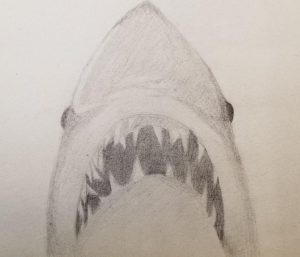The Meg falls short of classic thriller Jaws
October 8, 2018
Let’s face it: nobody is afraid of just a shark anymore. We need something bigger; more teeth. Bring in the Megalodon, a giant prehistoric shark that grew up to 60 feet long, dwarfing its smaller descendant the Great White by 40 feet.

In the movie The Meg a group of scientists breach a cloud at the bottom of the sea and find tons of prehistoric life; and unfortunately, that included the greatest sea predator in history. The Megalodon wreaks havoc and takes many lives until it is eventually stopped. Sound familiar?
You may have recognized its predecessor, a killer Great White shark from a much loved and feared movie from 1975, Jaws.
In Jaws the sheriff of the tourist town Amity Island finds himself with more than he can handle when a Great White shark makes its way into the bay and decides that it would be a good place to feast. He eventually takes it out the old-fashioned way: pyrotechnics.
In both movies the sharks go on a killing spree until they are stopped by the main protagonist of their respective films, but not before taking out some of the other protagonists along the way, or at least tricking us to think so.
Unlike Jaws, the plot of The Meg was entirely predictable, and the directors took the science behind the Megalodon and stretched it to proportions that were frightening, yes, but also completely wrong and far-fetched. The Megalodon was only documented to have grown up to 60 feet in length while in the film they state that the shark was about 90 feet long. That’s an extra almost 30 feet that they conjured out of thin air.
Speaking of the sharks themselves, compare the CGI of The Meg to the mechanical shark they used for Jaws. As expected, there are pros and cons to each.
CGI is a wonderful tool that allows producers to create beautiful or terrifying scenes that movie goers wouldn’t be able to recreate themselves, but how much is too much? The entire duration of The Meg was almost entirely CGI, which is understandable if you’re producing a movie about a 90 foot shark, but it doesn’t allow the actors to truly feel terrified if they’re staring at something that’s not there.
Instead of looking at a large shark, the actors had to look at a green screen almost the entire filming process. Meanwhile, when they were filming Jaws according to Gizmodo, they used a mechanical shark that was attached to a “twelve-ton steel platform, to which the mechanical shark was attached by a 100-ft.-long umbilical cable, had to be sunk to the ocean floor. The controls on the platform were operated by 13 technicians wearing scuba equipment.”
The actors in Jaws had to physically interact with the shark, named Bruce by the producers, by actually being dragged down into the water by Bruce and having to blow him up by the end of the film.
During a scene in The Meg, a scientist is trapped in a shark tank while it’s being swallowed whole by the Megalodon. She appears very calm and collected, only telling her co-workers “That’s the problem; it’s being swallowed.” While in Jaws the actors seem to be legitimately terrified, always yelling at their co-actors while the shark is attacking the boats or people.
Music makes the movie, every good producer knows that. Jaws had a soundtrack that we will not soon forget, the signature song that haunts the viewer’s dreams. However, that key element appears to be missing from The Meg. Again a contributing fact as to why the the thrill factor was missing from the movie.




